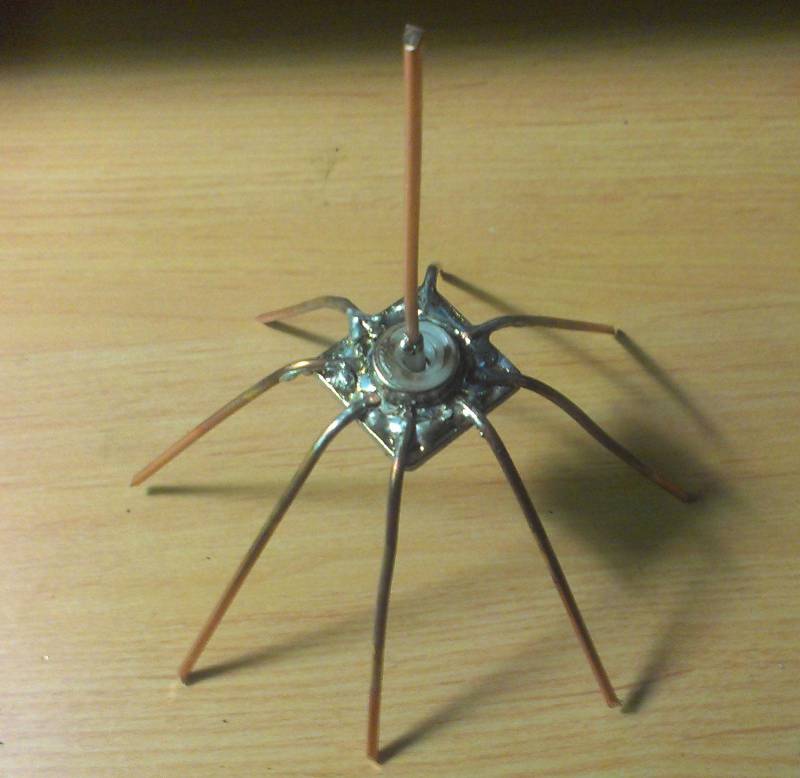
Being a pilot and living near several airports, I have an interest in seeing what kind of air traffic passes by from time to time. It's fun to see when the crop-dusters are coming in, or if the Cessna I hear is someone I know from the local flying club. Being able to recieve ADSB position data with a cheap RTL-SDR dongle is just like having your own radar station, but for way less money.
I have had flightaware running on a raspberry pi b+ for years now, but only with the cheap antenna it came with stuck to the desktop PC indoors. This should improve performance quite a bit, no matter where I end up mounting the antenna outside
I don't have any test equipment to match antennas over 500mhz, so the best I can do is borrow the dimensions from the internet and hope the design works out ok; although this is a recieve antenna so it's not like I need some kind of flawless SWR match.
What I can do is plug the dimensions through EZNEC and see what kind of performance to expect.
Looks like a pretty standard quarterwave vertical antenna pattern. There is that terrific null directly above the antenna though, and early testing revealed it really is a sharp null. Lower aircraft were still received ok when flying directly overhead, but a couple high altitude jets blinked off the display while passing overhead. I'm not sure there's much to be done about it either, as pretty much all omni-directional vertically-polarized antennas have a null like this. Still, they really had to be directly over the house to loose reception. Just a mile or two away and their flight path was recieved horizon to horizon.
Initial testing was done on the desk near a window with short coax. It was an improvement over the antenna that came with the radio dongle, but then a random-wire endfed antenna might have been an improvement. Now it's time to get some real coax on this antenna and put it outside. The antenna and receiver is 50ohm impedance, but since we're just receiving here some cheap (sometimes free, if you pull it off the house) 75ohm television coax will do. For the run length it would be nice to have a preamp to boost those low power signals before it's all attenuated by the coax.
To run our preamp we only need a few components: the preamp, 2x 2milliHenry inductors, a boost converter and a couple 1nf capacitors. With that we'll have our mast-mounted preamp and the bias-t to power it over the coax.
The preamp shown here was bought from amazon and sold under the name 'hiletgo'. Shown here are two modifications: removal of the lower SMA connector, and addition of 2 milliHenrys of inductance from the center pin to the power pin of the preamp. Yup, that's all it takes to wick the RF off and allow the DC power through from our bias-t. The capacitor on the board already takes care of keeping the DC from entering the preamp output pin. The SMA connector does not need to be removed, but it was easier to fit the coax in my enclosure by just direct soldering it.
Here is the antenna, the preamp, and a quick bracket I made up from an aluminum scrap.
The bias-t design is pretty simple: keep RF energy out of the DC powered devices, keep the DC voltage out of the RF ports. For a given frequency, the right capacitor will pass RF energy while blocking DC, while the inductors pass DC and block rf. All it takes is a boost converter, 2mH of inductance, and some capacitors. Schematic is below. Not much is critical about these values. I had to use two 1mH inductors in series, although it probably works fine with only 1mH as well. Current requirements are very low; whatever cheap boost converter you happen to have will probably be fine.
The preamp I"m using claims to operate on 5-15 volts, but looking at the oscilloscope I found the noise increased seemingly more than the signal did above about 10 volts. I've set this one to 9 volts, and added some jumpers to power the whole thing from the Raspberry Pi's 5v pin. Here is the enclosure I made, using only the finest quality breath-mint containers.
Now everything just gets hooked up in line: raspberry pi > SDR dongle > bias-t power supply > coax > preamp > antenna. Check back soon and I'll have this antenna installed and tested; right now it's pouring down rain so I"m not going to be climbing on the roof quite yet...